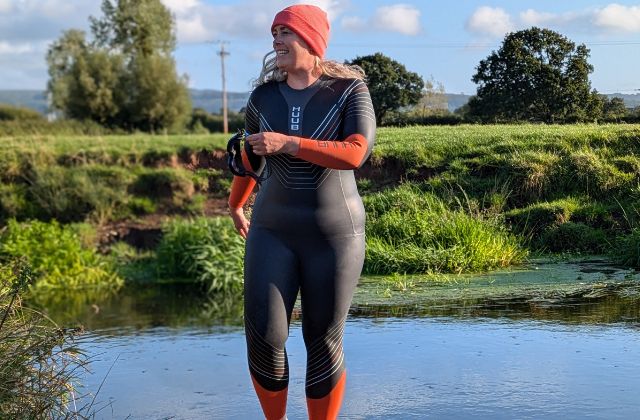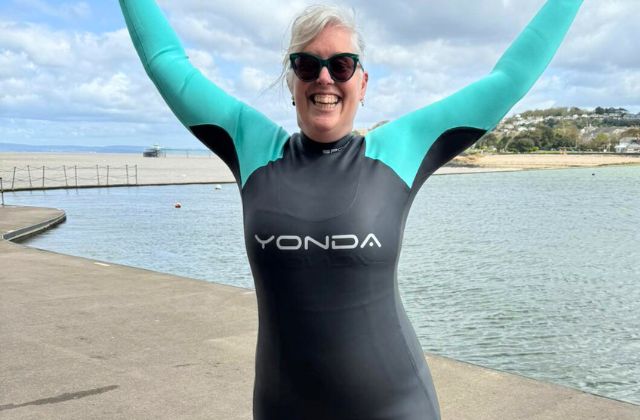Plus size open water swimmer, coach and outdoor swimming expert, Rowan Clarke, tests swimming wetsuits for plus size swimmers. Here's what she found.
For plus-size swimmers, wetsuit shopping can be a nightmare. While average women’s dress sizes in the UK and US are 16 to 18 (EU size 44), most wetsuits don’t go up to those sizes.
It’s also about design. Based on lean triathlete bodies, swimming wetsuits usually have extra buoyancy on the bum and legs. This is designed to lift muscle-dense legs for a more streamlined swimming position. But, this extra lift can disrupt your swimming position when you have in-built buoyancy panels, aka fat, on your bum and legs.
Thankfully, wetsuit brands are finally realising how many open water swimmers are size 16+. From entry-level brands to high-spec swimming wetsuits, you can shop for a wetsuit that enhances your open water swimming experience.
I’m a UK size 16-18 and 5’11” (180cm), which puts me on the smaller end of plus size but the 99th centile for height. To find information about wetsuit shopping for more sizes and body shapes, please scroll down to my buying guide.
At a glance
Best performance wetsuit for plus-size outdoor swimmers:
Best triathlon training plus size wetsuit:
Best entry-level all-round outdoor swimming wetsuit:
Best multisport durable wetsuit:
Lomo Nuotare Ladies Swimming Wetsuit

1 / HUUB Araya Wetsuit
Best performance wetsuit for plus-size outdoor swimmers
Specifications
- Arms Neutral positioning™
- High-grade neoprene
- Nylon-faced neoprene cuffs
- Upper body freedom and lower body lift
- Exclusive 2:4 buoyancy profile
- Smoothskin coating
Reasons to buy: Comfortable, flexible, inclusive sizing for taller or shorter swimmers, great performance at a reasonable price.
Reasons to avoid: Unwanted leg lift, limited sizing for bigger bodies
HUUB is renowned for its high-performing open water swimming kit. And so, I was really excited that plus-size swimmers are now included in their offering.
The HUUB Araya was my favourite plus-size wetsuit. However, that’s with the caveat that while I’m very tall, I’m on the smaller end of the plus-size scale.
The fit was great – well proportioned for my curvy hips, breasts and legs and the neoprene felt incredibly soft. But it was the shoulder flexibility that most impressed me. Using what HUUB calls ‘Arms Neutral positioning™’ gave me real freedom of movement – I swam for two hours without tiring.
I love that HUUB names its women’s plus-sizes Siren and Athena. Also, that female swimmers and lingerie designers helped shape these wetsuits. But, I could have done without the added buoyancy to the legs. The extra lift over-flexes my lumber spine.
Overall, a great fit and warm, comfortable, enhanced and empowered swim.
2 / Orca One piece Openwater Vitalis TRN wetsuit
Best triathlon training plus size wetsuit
Specifications
- For daily triathlon-oriented training
- High flexibility shoulders
- Laser cut neckline
- Smoothskin coating
Reasons to buy: Comfortable, flexible, inclusive sizing for taller or shorter swimmers, easy to get on and off
Reasons to avoid: The size grading doesn’t work for everyone
Orca is one of my go-to open water swimming brands because it sells a great range of products designed to enable people to enjoy the ocean. So, I was excited to find the popular Vitalis TRN wetsuit in plus sizes for men and women.
I tried this wetsuit on in LW, but it didn’t work for my shape. So, I passed it on to two swimmers who are 173cm (5’8”) and a UK dress size 20, and 167cm (5’6”) and a UK dress size 16-18.
Both women have previously had to buy men’s wetsuits. So, as fans of Orca, they were excited to try this wetsuit. They loved being able to slip it on without struggling. Tester one found the fit great on her body – well-proportioned for hips, breasts and legs. But the wetsuit was baggy on her legs. Our second tester found it a bit short and tight in the body, but it fitted her legs well.
We love that Orca has improved its sizing to include swimmers in bigger bodies. The wetsuit is soft, flexible and performs very well. We like the lower neckline for a chafe-free swim. But we did struggle a bit with the fit. However, it’s worth trying on.
3 / Yonda Spook Wetsuit
Best entry-level all-round outdoor swimming wetsuit
Reasons to buy: Comfortable, flexible, very inclusive sizing range, bright arms for visibility, neutral buoyancy, Facetime fitting help
Reasons to avoid: Not very technical, horrible size naming
Specifications
- Reasonable price point
- Bright sleeves for visibility
- Flexibility
- Suppleness, fit and comfort
- No aching arms or shoulders
- Enables breaststroke
- Performance tear-resistance material
- Taped seams for extra strength
When a friend suggested Yonda for inclusive sizing, I was sceptical. But its size range is extremely inclusive. This brought equal feelings of delight and horror. I felt dismayed at having to pick a size XXXL. But, having such a wide choice of sizes is wonderful in a market that serves plus sizes so poorly.
The Spook is a perfect fit. Long enough in the body, flexible, and comfortable, it offers compression without being restrictive. Thanks to lighter, stretchier neoprene on the turquoise or green arms, it’s so easy to swim front crawl. And, with no pesky buoyancy panels in the legs and bum, a neutral swimming position is yours.
However, it’s worth noting that the Spook lacks the refinement of other wetsuits. That means that for distance, endurance or triathlon swimming, it’s not going to enhance your performance like some of the technical suits.

4 / Lomo Nuotare Ladies Swimming Wetsuit
Best multisport durable wetsuit
Reasons to buy: Comfortable, flexible, very inclusive sizing range, super stretchy, neutral buoyancy, durable
Reasons to avoid: No Smoothskin coating
Specifications
- Double-lined Super Stretchy neoprene
- 3mm Torso panels for warmth
- 2mm Waist, legs and arms for warmth and flexibility
- Seam-free underarm area for improved comfort and flexibility
- YKK zipper with pull cord
- Internal zip flap to reduce water flushing and increase comfort
- Flatlock stitching throughout
Lomo’s inclusive sizing is unbeatable. Not only catering for different sized curves, it also accommodates different heights.
I was thrilled to see such a wide choice of sizes in a market that still serves plus-size swimmers so poorly. As well as standard sizes, Lomo offers three height options – short, medium and tall. And each height has a choice of widths, A, B or C.
The wetsuit was a perfect fit. Long enough in the body, it was the stretchiest, most flexible, comfortable wetsuit I have ever worn. When I first put it on, I did joyful lunges around the living room! This is thanks to its stretchy outer layer. And, with thinner neoprene on the legs than the body, you can swim in a neutral position.
However, there’s a trade-off. The super stretchy neoprene is not smooth-coated. That means it isn’t streamlined for swimming like more technical wetsuits. So, as an open water swimming wetsuit, it loses marks for its lack of smooth coating and technical features. But, as a wetsuit for a casual dipper, breaststroke swimmer or to jump on and off the paddleboard, you can’t beat it.
How to pick the right plus-size swimming wetsuit
With so many wetsuits on the market, wetsuit shopping is overwhelming. But, take a closer look and your choice will be narrowed down.
For a start, not all wetsuits are suitable for swimming. General-purpose wetsuits designed for surfing, paddleboarding etc are made of a thicker, rougher neoprene. This makes moving your arms harder and the lack of smooth coating creates drag.
Secondly, an XL in women’s wetsuits is often a UK 12-14 (US 8-10). So, having a bigger body narrows the field.
This is, of course, ridiculous. Research shows that middle-aged and older women are the biggest demographic in outdoor swimming. Swimming is an excellent exercise for menopause-related complaints from aching joints and hot flushes to regulating sleep and supporting good mental health. And, it’s a great leveller – an activity that people of any age, size and shape can enjoy.
Luckily, outdoor swimming brands are switching on to this and offering more inclusive sizing. But how do you choose the right wetsuit?
Your stroke
Start by thinking about what stroke you usually swim.
- Front crawlers: flexible shoulders, a neckline designed to minimise chafing, warmth and buoyancy on the torso.
- Breaststrokers: flexible shoulders and hips, neutral buoyancy.
If you swim breaststroke, a wetsuit can make your legs pop out of the water. So, it’s super important that your wetsuit doesn’t have thicker neoprene on the thighs. It may be worth considering getting a wetsuit with short or no legs.
Your style
Next, look at what kind of swimming you’ll be doing in your wetsuit. For example, triathletes and marathon swimmers will need a more technical wetsuit than a cold water dipper.
- Triathletes: Look for a smooth coating and seams to reduce drag, good compression for blood flow and quick transition zippers.
- Open water event/distance swimmers: Prioritise shoulder flexibility and support, drag-minimising coating, a soft neckline to reduce chafing and glued seams for warmth.
- Cold water dippers: Look for thicker neoprene on the torso, glued seams for warmth, and flexibility for swimming different strokes.
- Swim-runners: Look for thinner, stretchier material in the legs, front zip for heat regulation when running, short legs and sleeves, and pockets.
Buy and try
When choosing a wetsuit, use the brands’ sizing guides. As a general rule, you can exceed a height or weight bracket. For example, if you weigh 90kg you may be able to fit into a wetsuit made for 78-85kg. All bodies are different shapes, the size guide is just that – a guide.
It’s worth trying on a couple of wetsuits if you can. Pull the wetsuit up from your legs, make sure it fits into your crotch, then pull it up over your shoulders. Pull the arms up from the wrists so it fits into your armpits.
Your wetsuit should feel tight like it’s squeezing you, but not cutting off your blood supply. A good-fitting wetsuit should:
- Fit into the small of your back without a gap.
- Fit snugly with no excess fabric across the suit – if the suit isn’t snug, it will let in cold water.
- Fit into your armpits.
- Have only a small gap at the neckline.
Swimming in a wetsuit
Wetsuits feel different to swim in and they take getting used to.
You will feel cold water shock when you first get in the water because cold water will trickle down your neck and seep in through the seams and zipper. This is normal – in fact, you should let some water in to ensure you don’t have any air bubbles that disrupt your body position. A wetsuit works by trapping water between you and the neoprene. Your body then warms this water to body temperature and that’s what keeps you warm.
It’s normal to feel a bit of tightness across your chest and pressure on your shoulders, so start slowly and focus on relaxing your breathing. Providing your wetsuit fits well, this feeling will ease.
The wetsuit will also change your body position. You’ll feel more buoyant, so try to relax your body and let the wetsuit hold you. Keep your head low and eyes looking straight down to avoid strain on your lower back.
And lubricate. Your wetsuit may rub against your neck as you move it, especially in salt water. Use a neoprene-friendly lube like
to avoid damaging your new wetsuit.





